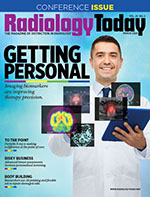 AI Insights: Ready for Takeoff
AI Insights: Ready for Takeoff
By Sandeep Akkaraju
Radiology Today
Vol. 25 No. 2 P. 10
It’s hard to believe it has been a year since we predicted 2023 would bring a shift toward homebased care, rapid adoption of point-of-care ultrasound (POCUS) technologies, and increased play for AI in medical imaging. Some of those played out as expected, while others have taken longer to come to fruition.
Unfortunately, many of the same challenges that have plagued the health care industry year over year continue to persist. With an aging population and a shrinking workforce, caregivers need support in delivering high-quality and efficient care for all. On top of that, nearly one-half of all nurses (47%) were reportedly still experiencing moderate to severe burnout at work as of earlier this year.
POCUS is a viable solution to many of these challenges, particularly in enabling affordable, efficient, “anywhere” care. Unfortunately, the technology still hasn’t taken off. According to a survey of more than 150 US-based caregivers, 62% of respondents have experienced major challenges when using POCUS devices. Current offerings do not seamlessly integrate with existing health care systems, involve complicated workflows, and can only be operated by a select few individuals with the proper training—all of which only exacerbate the issues the industry is already facing.
But there is one 2023 prediction that could still hold promise: the opportunity for AI in medical imaging. If the last year marked the rise of interest in AI, then 2024 will be the year we see the technology finally take off in health care by ushering in a new age of ultrasound. Here are our top predictions for how AI is going to revolutionize medical imaging in the year ahead.
Streamlined Imaging
AI will play a pivotal role across the entire end-to-end ultrasound process— from the initial image capture to image analysis, providing insights that will inform patient care. While ultrasound exams today can only be conducted by a select few trained individuals, a POCUS device equipped with AI is able to reference a database of millions of ultrasound images to aid the caregiver during image capture and interpretation. The technology continuously guides the user, simplifying image capture, identifying abnormalities, and delivering faster medical insights that will ultimately inform diagnoses.
This not only streamlines medical imaging processes for trained individuals but also enables a broader range of caregivers to engage in ultrasound procedures, no matter the location. The applications of AI in medical imaging can also reduce operator dependence and bias. The result will be more accurate, reliable, and consistent imaging, bolstering standardization across the medical imaging space.
With AI involved in every step, we’ll see a decrease in the process inefficiencies that have plagued medical imaging professionals. In fact, Exo’s survey also found that 63% of caregivers believe AI will streamline image interpretation.
New Pathways
Health care costs in the United States are expected to hit $6 trillion by 2027. This escalation is primarily influenced by an aging population, which tends to initiate health care interactions directly through emergency departments and urgent care centers. Since these facilities predominantly address reactive health care needs rather than prioritizing preventive measures, their reliance significantly contributes to the elevated costs within the US health care system.
To reduce this burden and create more accessible, affordable care, we will see a push for more patient care interactions happening in outpatient care facilities— which will need to be equipped with the same technology for imaging and diagnostics that traditional health centers have. AI-powered POCUS devices will be essential to enabling caregivers in outpatient facilities to properly assess patients by looking deep and wide into the body. Even novice users will have the power to leverage medical imaging to gather the answers they need to make a diagnosis. These portable, affordable, and powerful devices will be the key to finally unlocking new care pathways, ensuring that any person can visit any facility to receive treatment.
The Future of Health Systems
As of October 19, 2023, the FDA reported that there are over 692 market-cleared medical algorithms employing AI with a predominant focus on medical imaging. The organization also expects that new radiology algorithms will increase by over 100 annually.
With the applications of AI in medical imaging growing rapidly, hospitals and caregivers will be under pressure to invest in the right solution. Managing liability and risk poses a particular challenge, as health care providers must balance patient safety with the professional accountability of their staff and safeguard their systems against reputational, legal, or financial risks. To meet those needs while delivering a return on investment, health systems will prioritize FDA-cleared solutions that are built for and by caregivers— those who uniquely understand the opportunity for AI in medical imaging and the functionalities that will ensure ease of use. Additionally, to build patient trust, health systems will need AI that is transparent and requires caregiver involvement to make a diagnosis.
Redesigning medical imaging for the modern age can make health care faster, more accessible, and more affordable for all—and AI will be the key to unlocking that in the year ahead. As AI-enabled POCUS becomes a reality in 2024, caregivers will be able to practice without limits and patients will be able to receive quality care from anywhere.
— Sandeep Akkaraju is the CEO of Exo.

